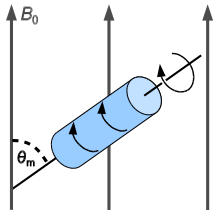Magic angle spinning

In nuclear magnetic resonance, magic-angle spinning (MAS) is a technique often used to perform experiments in solid-state NMR spectroscopy and, more recently, liquid Proton nuclear magnetic resonance.[1][2]
By spinning the sample (usually at a frequency of 1 to 130 kHz) at the magic angle θm (ca. 54.74°, where cos2θm=1/3) with respect to the direction of the magnetic field, the normally broad lines become narrower, increasing the resolution for better identification and analysis of the spectrum.
In any condensed phase, a nuclear spin experiences a great number of interactions. The main three interactions (dipolar, chemical shift anisotropy, quadrupolar) often lead to very broad and featureless lines. However, these three interactions in solids are orientation-dependent and can be averaged by MAS. The nuclear dipole-dipole interaction, between magnetic moments of nuclei averages to zero only at the magic angle, θm . The chemical shift anisotropy, a nuclear-electron interaction, averages to a non-zero value. The quadrupolar interaction is only partially averaged by MAS leaving a residual secondary quadrupolar interaction. In liquids, e.g. a solution of an organic compound, most of these interactions will average out because of the rapid time-averaged molecular motion that occurs. This orientation averaging in solution is mimicked by MAS of a solid. This causes the signal to become much narrower, giving rise to the isotropic value (which is of interest for structural determination of solid materials and compounds) and spinning sidebands which occur at multiples of the spinning speed and can be used to determine the chemical shift anisotropy of the nuclei.
The physical spinning of the sample is achieved via an air turbine mechanism. These turbines (or rotors) come in a variety of diameters (outside diameter), from 0.70–15.0 mm, and are usually spun on air or nitrogen gas. The rotors are made from a number of different materials such as ceramics e.g. zirconia, silicon nitride or polymers such as poly(methyl methacrylate) (PMMA), polyoxymethylene (POM). The cylindrical rotors are axially symmetric about the axis of rotation. Samples are packed into the rotors and these are then sealed with a single or double end cap. These caps are made from number of different materials e.g. Kel-F, Vespel, zirconia or boron nitride depending on the application required.
Magic-angle spinning was first described in 1958 by Edward Raymond Andrew, A. Bradbury, and R. G. Eades[3] and independently in 1959 by I. J. Lowe.[4] The name "magic-angle spinning" was coined in 1960 by Cornelis J. Gorter at the AMPERE congress in Pisa.[1]
Variations
High Resolution Magic-Angle Spinning (HR-MAS)
HRMAS is usually applied to solutions and gels where there is some internal molecular motion, but the dipole-dipole interactions are insufficiently averaged by such motion. Under these conditions, HRMAS can dramatically average out the dipole-dipole broadening and result in spectra similar to high resolution NMR. This permits the kind of quantitative analysis of components practiced in solution NMR, e.g.[5]
Cross Polarization Magic-Angle Spinning (CP-MAS)
By combining cross polarization with MAS, high resolution spectra can be obtained for rigid solids.
Solution Magic Angle Spinning
Use of Magic Angle Spinning has been extended from solid-state to liquid (solution) NMR.[6]
References
- ^ a b Jacek W. Hennel; Jacek Klinowski (2005). "Magic Angle Spinning: A Historical Perspective". In Jacek Klinowski (ed.). New techniques in solid-state NMR. Vol. 246. Springer. pp. 1–14. doi:10.1007/b98646. ISBN 978-3-540-22168-5. PMID 22160286.
{{cite book}}:|journal=ignored (help) (New techniques in solid-state NMR, p. 1, at Google Books) - ^ E. Raymond Andrew (2010). "Magic Angle Spinning". In Anne McDermott (ed.). Solid State NMR Studies of Biopolymers. John Wiley & Sons. pp. 83–97. ISBN 978-0-470-72122-3. (Solid State NMR Studies of Biopolymers, p. 83, at Google Books)
- ^ E. R. Andrew; A. Bradbury; R. G. Eades (1958). "Nuclear magnetic resonance spectra from a crystal rotated at high speed". Nature. 182 (4650): 1659. Bibcode:1958Natur.182.1659A. doi:10.1038/1821659a0.
- ^ I. J. Lowe (1959). "Free Induction Decays of Rotating Solids". Phys. Rev. Lett. 2 (7): 285–287. Bibcode:1959PhRvL...2..285L. doi:10.1103/PhysRevLett.2.285.
- ^ Händel, Heidi; Gesele, Elke; Gottschall, Klaus; Albert, Klaus (2003). "Application of HRMAS 1H NMR Spectroscopy To Investigate Interactions between Ligands and Synthetic Receptors". Angewandte Chemie International Edition. 42 (4): 438–442. doi:10.1002/anie.200390133.
- ^ "Magic Angle Spinning NMR Spectroscopy: A Versatile Technique for Structural and Dynamic Analysis of Solid-Phase Systems". Analytical Chemistry. 87 (11): 5458–5469. 20 Mar 2016. doi:10.1021/ac504288u. PMC 4890703. PMID 25794311.
{{cite journal}}: Unknown parameter|authors=ignored (help)
